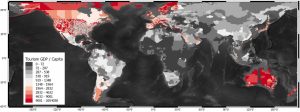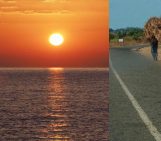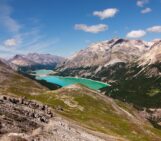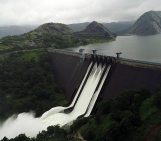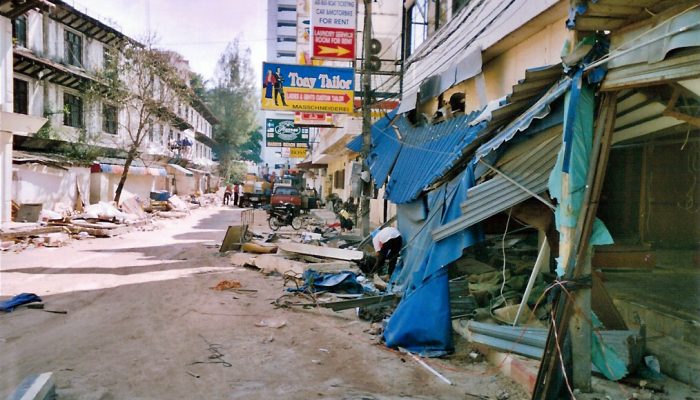
December 2004 saw one of the deadliest natural disasters in recorded history. 228,000 people were killed when an earthquake off the coast of the Indonesian island of Sumatra triggered tsunami waves up to 30 m high. The destruction was extreme as the waves hit 14 different countries around the Indian Ocean. Economic losses totalled over 10 billion US dollars. The tourism industry in particular suffered a significant blow. In Phuket, a province of Thailand, a quarter of the island’s hotels had closed six months after the tsumani.
“The 2004 Sumatra tsunami and some of the recent Pacific Island tsunamis have shown their devastating impact on beaches and beach-related tourism,” says Andreas Schaefer, a researcher from the Karlsruhe Institute of Technology (KIT). But where is disaster likely to strike next? And can we be prepared for it?
Schaefer and his colleagues are trying to find out. “We asked the question: can we quantify potential tsunami losses to tourism industries along beaches?” he says. The number of tourists visiting the most exotic locations in the world, places such as Thailand, Indonesia, Colombia and Costa Rica, are rising twice as fast as the global average. In some cases, visitor numbers are growing by as much as 11 percent each year.
This rise in tourism in tsunami-prone locations is potentially a cause for real concern. “We compiled the first ever global loss index for the tourism industry [associated with beaches],” continues Schaefer. His findings were presented last month at the European Geosciences Union General Assembly in Vienna .
Beaches can be affected by tsunamis in a variety of ways. As well as the immediate threat to human life, a tsunami wave can leave behind piles of debris or offshore sand that can damage a beach environment. Alternatively, large swathes of beach sand might be removed by erosion. And in cases where an earthquake is very close to the shore, the beach itself may be down-thrust or uplifted during the event, leaving it either permanently submerged underwater or high and dry.
To quantify the locations in the world that are most at risk, Schaefer and his colleagues used two large datasets: tourist information and earthquake statistics.
To calculate the human exposure, “we compiled a global tourism destination database,” he explains. This database includes over 200 countries, at least 10,000 tourist destinations, more than 24,000 beaches, and almost a million hotels from all around the globe.
“It was important to get the latest and best tourism and hotel information,” says James Daniell, another member of the KIT research team. “Tourism contributes over 6 trillion [US] dollars directly and indirectly to the global economy every year.”
The research team then calculated tsunami probabilities all around the world using earthquake statistics and tectonic modelling. Chile, central America, Indonesia and Japan are the main countries that frequently experience large tsunamis.
Over longer time periods, the Caribbean and Mediterranean are also likely to be affected by rarer events. To put the numbers in perspective, if you spend a day on the coast of Mexico you have a one in 60,000 chance of seeing a tsunami; in Crete, this decreases to one in 600,000.
To model the tsunamis, it is also important to have a good understanding of the shape of the seafloor in the vicinity of the tourist sites. In the deep ocean, big tsunamis can have gaps between waves of as much as 200 km and wave heights as small as 1 m; ships are often unable to feel them passing. But as they approach the shore, the water shallows, causing the waves to slow down and pile up. The wave spacing decreases to less than 20 km, whilst the wave heights can grow to tens of metres. Hence, what looks like an innocuous fluctuation at sea can cause major damage when it reaches land. The depth of the adjacent seafloor plays a major role in this.
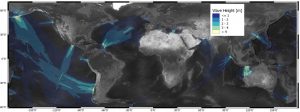
Simulated tsunamis across the world showing maximum potential wave heights. (Image credit: Andreas Schaefer)
Given the large number of variables at play, tsunami modelling involves many calculations and typically requires the use of a supercomputer. But in a paper published last year, Schaefer helped to develop a new simulation framework called TsuPy, which allows for quick modelling of tsunamis on personal computers. With this in place, he could rapidly simulate more than 10,000 tsunamis all around the world, calculate the expected wave heights at the tourist sites in his database, and estimate the likely economic losses.
The researchers estimate 250 million US dollars in global annual loss to the tourism industry from tsunami waves. Furthermore, every 10 years they expect a single $1 billion event.
Of all the tourist destinations, “Hawaii is the number one,” says Schaefer. This is “because of all the potential tsunamis that come from around the Pacific Ring of Fire,” he explains. “There are so many [tsunami] sources all around, that, even though they are far away, they have an effect.”
The last major tsunami to strike Hawaii was as a result of the biggest earthquake ever recorded: the 1960 magnitude 9.6 Valdivia earthquake on the coast of Chile. 60 people on Hawaii were killed and the damage amounted to 500 million US dollars in today’s terms.
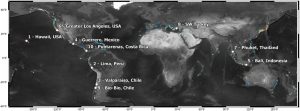
Top ten locations on the global risk index for beach tourist destinations threatened by tsunamis. (Image credit: Andreas Schaefer)
Other notable locations on the top ten list include Valparaiso (Chile), Bali (Indonesia), and Phuket (Thailand). “Locations that are known for their tourism are at the top of the list because there is a lot [of existing infrastructure] that could be damaged,” explains Schaefer.
Slightly surprisingly, southwest Turkey is also high on the list. Furthermore, places like Tonga and Vanuatu are particularly at risk. They have rapidly developing tourist industries and large projected losses per dollar of tourism-related business, so they feature highly on Schaefer’s list. “They are mostly small island nations with a significant need for tourist dollars,” explains Daniell.
For many parts of the world, the results are not necessarily good news. But they are a first step inasmuch as they highlight the locations that are currently thought to be at greatest risk. “We hope, with these results, to raise awareness among tourists. But they do not need to be afraid,” says Schaefer. With adequate preparation and evacuation planning, it is hoped that future disaster on the scale of the 2004 event might be averted.
By Tim Middleton, EGU 2018 General Assembly Press Assistant
References
Schaefer, A., Daniell, J., and Wenzel, F. Beach Tsunami Risk Modelling – A probabilistic assessment of tsunami risk for the world’s most prominent beaches. Geophysical Research Abstracts, Vol. 20, EGU2018-11955, 2018, EGU General Assembly 2018 (conference abstract)
Schaefer, A. and Wenzel, F. TsuPy: Computational robustness in Tsunami hazard modelling. Computers & Geosciences, 102, 148-157, 2017

